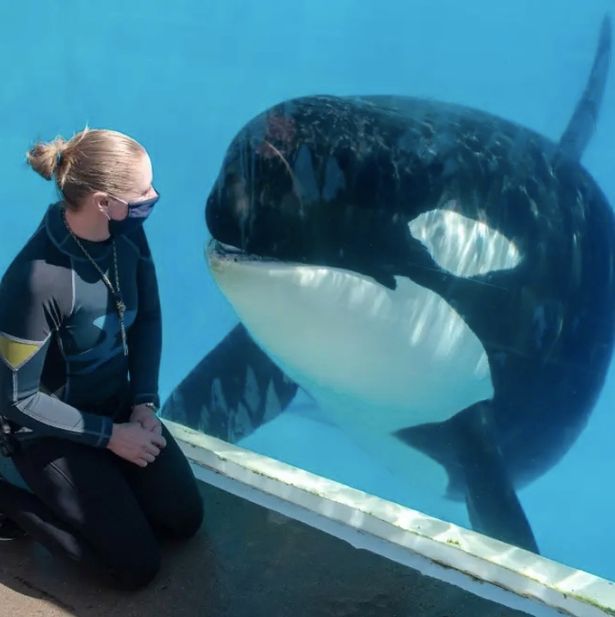As the horrified audience watch on, the two orcas repeatedly slam into the young man, leaving him bruised and bloody from the attack.
In 2016, SeaWorld officially ended its killer whale breeding program, making the ones already in their parks the last. Many people celebrated this announcement. Research has found that orcas do not thrive in captivity. For one, they are massive creatures who swim 40 miles a day on average in the wild, diving 100 to 500 feet. Captivity is a stressful environment for them, and many believe that this stress leads to aggression against humans, causing cases where trainers suffered from injuries — and one death.
SeaWorld Trainer Almost Drowns Because of Orca
One of these most famous horror moments at SeaWorld occurred in March 1987. Killer whale Kandu V was captured as a baby and struggled with adjusting to captivity. Ten years later, Kandu was in a show with her 21-year-old trainer, Jonathan Smith. Suddenly, the orca grabbed Smith with her teeth and pulled him to the bottom of the tank before releasing him. Smith tried to reassure the crowd by waving until another orca crashed into him. The two whales repeatedly slam into him and try to drown him. Smith escaped with cuts all over his torso, a ruptured kidney, and a wound on his liver. He sued the park a year later claiming that the “dangerous propensities of killer whales” were not taught to him. In fact, he claimed he received no formal training. [1]

In 1988, Smith said in an interview that he thought the orcas would kill him. “I remember it crystal clear,” he said. “I think there came a point where I may have thought, ‘This is it, I’m going to die’. Not only have I suffered physically, I think to an extent I have suffered emotionally as well. I am still recovering… I’m not up to 100 per cent physical shape or near that yet.”
In 2006, an orca called Kasatka grabbed her trainer Ken Peters by his foot and dragged him into the water. The killer whale held him like this for about a minute. At the time, Peters struggled for air and tried to calm the creature by patting her back. When he’s finally released, Peters rushes out of the pool, stumbling and falling to get out of the reach of Kasatka as she follows him. He received aid for his broken foot afterward. There were no safety improvements after this incident, other than telling trainers not to swim with Kasatka and two other killer whales. [2]
The Death of Dawn Brancheau
In 2010, an even more horrific incident took place at SeaWorld. Killer whale Tilikum killed his trainer Dawn Brancheau by grabbing her ponytail and dragging her underwater. According to the sheriff’s statement, Brancheau “most likely died from multiple traumatic injuries and drowning after one of the park’s killer whales pulled her into a pool behind Shamu Stadium.” Brancheau had been interacting with the orca in knee-deep water “when the animal grabbed her by the hair, said to be in a long ponytail, and pulled her underwater.”
Jaime Zalac, a spokesman for PETA, called this death “a tragedy that didn’t have to happen.” The organization had called on SeaWorld “to stop confining oceangoing mammals to an area that to them is like the size of a bathtub, and we have also been asking the park to stop forcing the animals to perform silly tricks over and over again. It’s not surprising when these huge, smart animals lash out.” [3]
Tilikum was linked to two other deaths, one in 1991 in a park in Canada where he and two other orcas stopped a trainer from swimming out of the tank. The second occurred in 1999 in SeaWorld Orlando when a man snuck into the park during the night and was found dead next to the whale the next morning. An inquest found that he had died from hypothermia but it also looked like the whale had bitten the man and torn off his pants.
Tilikum died in 2017 at age 36, a sadly shorter life compared to his brethren in the wild who often live to their 50s or 70s. [4] He’s one of many killer whales who died young in captivity.
“It’s basic biology,” said Naomi Rose, a marine mammal scientist at the Animal Welfare Institute. Orcas born in captivity have the same nature as those born in the wild.
“If you have evolved to move great distances to look for food and mates then you are adapted to that type of movement, whether you’re a polar bear or an elephant or an orca. You put [orcas] in a box that is 150 feet long by 90 feet wide by 30 feet deep and you’re basically turning them into a couch potato.”
Because of this, orcas struggle in confinement. Elephants in zoos can suffer from the same issue. However, it’s much harder to recreate an ocean than a savannah. “Not one marine mammal is adapted to thrive in the world we’ve made for them in a concrete box,” Rose said.
Therefore, people have rallied for the killer whales, sympathizing with those in SeaWorld and similar parks instead of villainizing them for the incidents of aggression. Many seem to agree; orcas belong in the ocean, not in tanks. And once all of those still in captivity die out, the ocean will be the only place to see them in action. [5]






